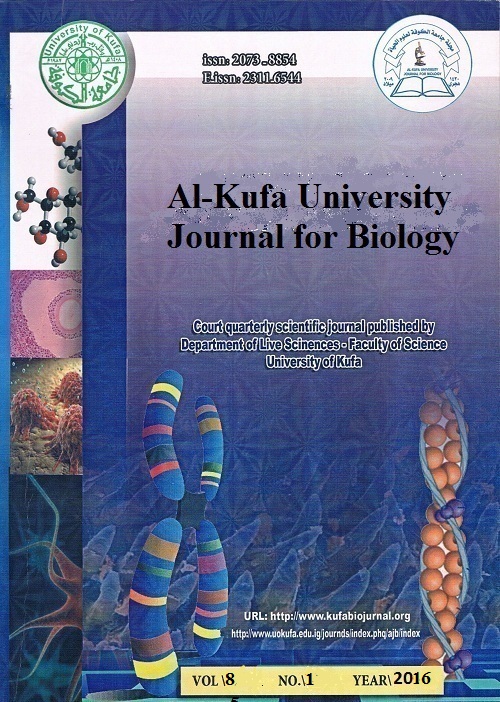Impact of Rustumiya Station for Sewage Water Treatment on Bacterial Pollution of Diyala River
DOI:
https://doi.org/10.36320/ajb/v8.i1.8023Keywords:
Diyala River, bacterial pollution, Rustumiya station.Abstract
The bacterial pollution of Diyala River (Iraq) was studied, especially the impact of Rustumiya station for sewage treatment. Surface water samples from Diyala River at Baghdad city of Iraq were collected in four seasons; summer, winter, spring and autumn of 2016, to examine the following parameters (Fecal Coliform Bacteria (FC), Escherichia coli (E. coli) and Fecal Streptococci (FS). It observed by the results that the proportions of the microbial pollution has exceeded the prescribed system maintenance Iraqi rivers, especially at the third station as the Diyala River has been affected greatly as posed streams Rustumiya station to the river, which negatively affects aquatic life on one hand and on the farmland on both sides the river on the other hand, where the river water used for irrigationDownloads
References
Ali, L. H. (1991). "Industrial Pollution", Mosul University. (In Arabic).
Hughes, L. (1989). "Environmental pollution". Translated by Mohammed Ammar Al - Rawi and Abdul Rahim Asheer. Baghdad University.
Hammer. M. J. (2008).Water and Wastewater Technology 6th Ed.
Al-Fahdawi, H. J. (1999). Master Thesis, Faculty of Education, University of Basra. (In Arabic).
Hammadi, A. H., Khaled R. and Ahmad R. (2005). Journal of Science Mustansiriya 23, 16 (4). (In Arabic).
Haitham A. H. (2010). Dependable discharges of the upper and middle Diyala basins.Vol. 2 (16) Journal of Engineering.
UN-ESCWA and BGR (United Nations Economic and Social Commission for Western Asia; Bundesanstalt für Geowissenschaften und Rohstoffe) (2013). Inven(UN-ESCWA and BGR, 2013) tory of Shared Water Resources in Western Asia. Beirut. Shared Tributaries of the Tigris River Chapter 4. http://waterinventory.org/sites/waterinventory.org/files/chapters/Chapter-04-Shared-Tributaries-of-the-Tigris-web_1.pdf.
Shahin, M. (2007). Water Resources and Hydrometeorology of the Arab Region. In Water Science and Technology. DOI: https://doi.org/10.1007/1-4020-5414-9
APHA, AWWA and WFF (2005). Standard Methods for the Examination of Water and wastewater, 21th ed., edited by Eaton, A. D American Water Work Association and Water Environment Federation, USA.
SAS. (2012). Statistical Analysis System, User's Guide. Statistical. Version 9.1th ed. SAS. Inst. Inc. Cary. N.C. USA.
Hader, D.P.; Kumar, H.D.; Smith, R.C. and Dobler, W.I. (1998). Effects on aquatic ecosystems. J. Photochem. And Photobiol.Vol.46: 53-68. DOI: https://doi.org/10.1016/S1011-1344(98)00185-7
Adams, S. B. and Kolo, R. J. (2006). Public health implications of Gurara River around Izam Environs, Niger State, Nigeria. Fisheries Society of Nigeria (FISON). Conference Proceedings.
Davies, C. R. J.; Donnison, A. M.; Speed, D. J.; Ross, C. M. and Nagels, J. W. (1999). Inactivation of fecal indicator microorganisms in waste stabilization ponds interactions of environmental factors with sun light. Water Res.Vol.33: 1220 – 1230. DOI: https://doi.org/10.1016/S0043-1354(98)00321-2
Abdo, M. H.; Sabae, S. Z.; Haroon, B. M.; Refaat, B.M. and Mohammed, A. S. (2010). Physico-chemical characteristics, microbial assessment and antibiotic susceptibility of pathogenic bacteria of Ismailia Canal Water, River Nile, Egypt. J. American Sci. Vol. 6(5) pp: 243-250. http://www.americanscience.org.
Al-Mayaly, I.K.; B.H. Maroof and H.A.AL-Saadi. (2000). Limnological characters of Diyala River and their effect on Tigris River. The first scientific National in environmental pollution and protection, 5-6 dec.2000. (In Arabic).
Hashim, A. G. and Rabee, A. M. (2014). Impact of Diyala Tributary on the Quality of Tigris River Water.Vol. 9(4) pp: 493-504.
AL-Khaledy, S. H. H. (2003). Ecological and Bacteriological Study in the South Part of Diyala River. MSc Thesis, College of Science for Women, University of Baghdad, Iraq. (In Arabic).
Chapman, D. (1996). Water Quality Assessments: A Guide to the Use of Biota, Sediments and Water.Environmental monitoring, 2 ed. UNESCO, WHO and UNEP. E & FN Spon, London UK.
Downloads
Published
How to Cite
Issue
Section
License
Copyright (c) 2019 Ayad Gh. Hashim

This work is licensed under a Creative Commons Attribution 4.0 International License.
which allows users to copy, create extracts, abstracts, and new works from the Article, alter and revise the Article, and make commercial use of the Article (including reuse and/or resale of the Article by commercial entities), provided the user gives appropriate credit (with a link to the formal publication through the relevant DOI), provides a link to the license, indicates if changes were made and the licensor is not represented as endorsing the use made of the work.












